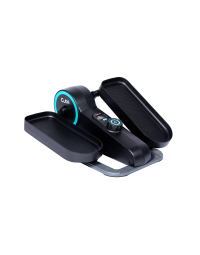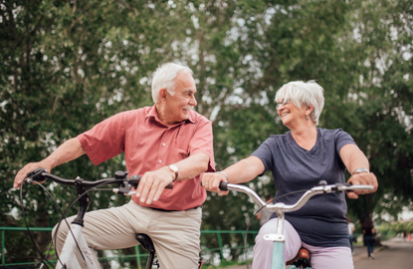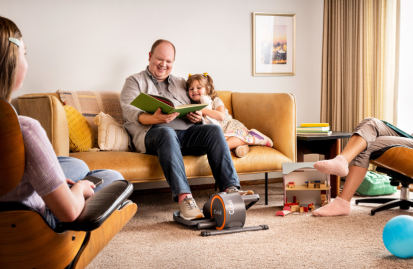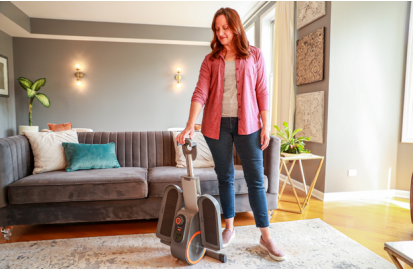The Importance of Staying Active As We Age
Being physically active and exercising is crucial to staying healthy and aging well - especially as we get older. Countless articles provide evidence of the benefits of physical activity and exercise. And one visit to the doctor’s office is all it takes to hear this same sentiment.
The message is clear: inactivity is detrimental to our health, while physical activity can help offset several health concerns and increase vitality. Still, statistics show that only 35-44% of people over 75 are physically active, and the numbers are even lower for those between the ages of 65 to 75 (1).
When we think of aging, many often picture more visits to the doctor and a declining ability to do things independently. And yes, it is normal for stamina to decrease as we age, but this does not destine us to become couch potatoes. The reality is that lack of physical activity is more to blame for losing the ability to do things independently than age.
The good news is that staying active benefits our physical, emotional, and mental health. Even those already dealing with health issues can reap these benefits too.
Benefits of exercise and physical activity for older adults
According to the CDC, physical activity is one of only a handful of lifestyle-related actions we can take that have a tremendous impact on our health, and what’s great is that exercise is something that anyone can do, regardless of size, ethnicity, and abilities. (2) Some of the benefits of physical activity include:
Improved mobility and improved pain
Our ability to move with ease relies on healthy bones and joints. A sedentary lifestyle leads to joint stiffness, pain, and loss of bone mass.
Simple exercises, such as walking, can help improve joint stiffness and pain, help control your weight, and improve your mobility (3). While moving stiff and achy joints may seem counterintuitive, movement is necessary to get lubrication into the joint. Not to mention exercise helps develop the muscles around our joints, which helps in relieving some of the pressure on our joints that could be causing pain.
Fall prevention
As highlighted, healthy bones and joints are integral to mobility. Exercises, such as strength and resistance training, help to counteract the natural bone loss we experience as we age. (2,4) Maximized bone density helps prevent injury and keeps you doing things independently by reducing your fall risk.
Disease prevention
Although the exact mechanism is unclear, studies have shown that exercise helps boost the immune system (4), which results in fewer ailments, such as the common cold, flu, and respiratory tract infections.
Moderate physical activity and exercise also help reduce the risk of heart disease through improved blood pressure and cholesterol, reducing your risk of heart attacks and stroke. For those already experiencing heart disease, physical activity helps to improve symptoms, which helps with quality of life. (2,4)
Exercise also helps prevent and improve type 2 diabetes (2), as diabetes can often be reversed or improved through weight loss alone.
Lastly, one study showed that people who exercise for only 30 minutes a day had fewer biomarkers for cognitive-related diseases, such as Alzheimer’s dementia (4).
Improved sleep
Research shows that as little as 30 minutes of aerobic exercise a day, such as walking or swimming, helps to improve the quality of your sleep. (5). Fortunately, this benefit is one that you won’t have to wait weeks or months to kick in. Sleep generally improves the day you start exercising.
While most studies focus on aerobic exercise and its effect on sleep, any activity that elevates your heart rate will have the same effect. Be sure to exercise earlier in the day if you feel that exercise will interfere with your ability to fall asleep.
Increased energy
In addition to improved sleep, energy levels also improve with regular physical activity. (5) Whether this boost in energy is due to improved utilization of energy storage and oxygen as endurance increases or improved sleep, this benefit is one that everyone can appreciate.
Emotional well-being
Lastly, in addition to physical benefits, exercise also helps with your emotional well-being. For many, exercise provides an opportunity to socialize, which helps stave off feelings of isolation and loneliness.
Exercise releases endorphins, which help to produce feelings of happiness. Additionally, physical activity makes you more sensitive to hormones in the brain that help combat the blues. And while the effects are not as immediate as those seen with sleep, they usually only take a few weeks to kick in (5).
Quick Takeaways:
- Staying active and exercising is essential for good health and vitality
- Everyone can stay physically active regardless of age, size, and ability
- Physical activity and exercise help with mobility and pain, prevent falls, help with disease prevention, improve sleep and energy levels, and improve mood
What exercises are suitable for older adults?
Since the benefits of exercise include those gained from aerobic exercise, strength training, and flexibility exercises, the ideal workout program should consist of all three. Also, it is essential to note that jumping into the latest HIIT cardio trends could lead to injury, so finding a balance of sensible exercises is the way to go - especially if you’re just getting into being physically active.
Calisthenics and strength training
Calisthenic exercises, such as push-ups and bridges, only require your body weight and are low-impact. While calisthenics is excellent for building muscle and endurance, you can elevate these exercises by adding light weights or resistance bands, which allows you to include other movements, such as bicep curls and shoulder presses. In addition, as highlighted above, strength training helps build muscles, which not only improves balance and coordination but also helps relieve pressure on the joints.
Yoga
Yoga is another low-impact exercise that will help strengthen muscle, flexibility, and core. And many facilities offer chair yoga, which is an excellent option for those with less mobility. Increased flexibility is a great way to prevent injury while alleviating aches. Try a free Cubii Studio+ chair yoga class by downloading the Cubii mobile app.
Pilates
Like yoga, pilates focuses on flexibility and strengthening with less focus on the mind-body connection, as seen in yoga. You can modify pilates by using a chair or moving in a seated position, which means this exercise is excellent for everyone, no matter their ability. Pilates is known to dramatically affect the symptoms of multiple sclerosis (MS), Parkinson’s, and arthritis. (4)
Aerobic exercises
Lastly, many aerobic exercise options, from walking, swimming, cycling, and dancing, provide flexibility for different abilities. In addition, aerobic exercise helps increase your heart rate while providing a great bodyweight workout- both of which are great for your heart and bones. And most aerobic exercises are adaptable for those that may need to use a cane or walker to participate.
So, whether you choose to walk, lift weights at the gym, exercise using an under-desk elliptical, or hit up a yoga class- all these exercises and many others are great to do on your own or with a group depending on your preference.
How much exercise do older adults need?
The Physical Guidelines for Americans recommend that older adults aim to get a minimum of 2.5 hours of moderate-intensity aerobic activity every week, which is about 150 minutes that you should spread out over several days. Also, older adults should do two days of strength training, whether with weights or without. And if you prefer a more intense aerobic exercise, such as running, the guidelines recommend a minimum of 75 minutes a week.
Tips for getting started
It can be hard to know where to begin if you're not physically active. The best thing to remember is to start slow and build on your current activity level to avoid getting injured.
Here are some other tips for getting started with exercise and physical activity: (6)
- Start with low-impact activities, such as slow walking, pedaling on a seated elliptical, or light yoga
- Warm up and cool down every time you exercise
- Stay hydrated by drinking lots of fluid daily, especially when exercising.
- Wear appropriate clothing to prevent overheating or skin irritation
- Pay attention to your surroundings if exercising outdoors
- Consult your physician for any specific health concerns
And, lastly - have fun! You’re doing something good for your health, but it still should be fun!
Quick Takeaways:
- The ideal workout program for older adults includes resistance or strength training, aerobic exercise, and flexibility work. But, any exercise and regular movement are better than none.
- Strength training can be done using bodyweight alone or light weights. Yoga and pilates are both great exercises for strengthening and flexibility.
- Aerobic exercise can include walking, cycling, swimming, or dancing; you can modify this according to your ability.
- Older adults should get a minimum of 150 minutes, or 2.5 hours, of moderate-intensity aerobic exercise a week, spread over several days, with two days of strength training and flexibility work.
Where can older adults exercise?
Many communities have walking trails or community centers available to the public to use for walking, running, cycling, and more. If you’re not close to either of these options, there are other ways that older adults can get out of their homes to exercise:
- YMCA: many YMCA gyms have indoor and outdoor tracks for walking and running. Indoor tracks are great when the weather outside is not pleasant. YMCA gyms also offer group fitness classes, such as chair aerobics and yoga. YMCA clubs may also have tennis and pickleball courts.
- Golf course: Many older adults enjoy golf for physical activity. This sport often includes a good amount of walking and provides the perk of socializing as you move.
- Join a social club: There are groups, such as Silver Sneakers, that you can join to receive health benefits and meet other like-minded older adults you can meet up with to walk, cycle, or run.
- Join a walking club: Many communities have fitness-centered groups for older adults who meet for walks. Again, this option is another way to socialize while moving.
While this list is certainly not exhaustive, it aims to give you some ideas on how you can get out to get your body moving while getting out of the house. If you prefer at-home exercise, we offer an array of desk exercise equipment and accessories to help you get started.
Quick Takeaways:
- Some tips for starting physical activity and exercise include starting slow and low-impact activities to avoid injury.
- Remember to warm up and cool down to avoid injury.
- Stay hydrated by drinking plenty of water, especially during exercise.
- Wear appropriate clothing to avoid overheating and skin irritation.
- Pay attention to your surroundings when outside.
- Talk to your doctor about any specific health concerns before beginning.
There are so many options for getting outside to move your body, from the outdoor walking paths and tracks to golf courses, social clubs that pair up like-minded people, and walking clubs
To wrap up, there are many benefits to staying active, including less risk for injury and improved mobility; disease prevention of certain diseases, such as diabetes, cancer, and heart disease; better sleep and more energy; and improved emotional well-being.
While exercise can take many forms, the Physical Guidelines for Americans recommends that older adults get 150 minutes of moderate-intensity exercise each week with at least two sessions of strength training included. Exercise can consist of walking, calisthenic exercises, such as push-ups and squats, dancing, swimming, lifting weights, and so much more.
There are many options to get out and exercise, from walking paths, local YMCA gyms, golf courses, walking clubs, and more.
The options to stay active are endless, and your health will thank you! So, what are you waiting for? Get out and get moving!
Sources:
- Exercise & Fitness: Facts & Statistics – RxResource.org
- Benefits of Physical Activity | Physical Activity | CDC
- Stiff Joints: Why They Hurt and How to Treat Them (healthline.com)
- The Life-Changing Benefits of Exercise After 60 (ncoa.org)
- Exercise: The Top 10 Benefits of Regular Physical Activity (healthline.com)
- How Older Adults Can Get Started With Exercise | National Institute on Aging (nih.gov)








